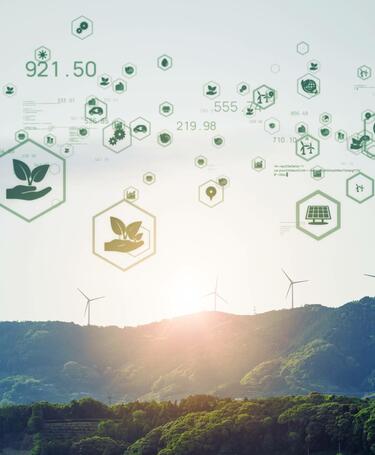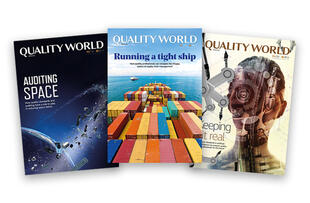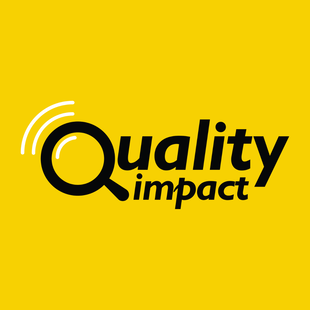
Take a risk to mitigate climate change
Progress indicator

Could a structured risk assessment help organisations achieve the UN’s Sustainable Development Goals while mitigating climate change, asks Zoi Kontodimou, Chair of the CQI’s Sustainability special interest group.
Climate change is one of the most critical challenges facing our world, and requires our urgent attention and action. The 2015 Paris Agreement aimed to address this by setting ambitious carbon reduction targets for participating countries, with the goal of limiting the rise in global temperatures to below 1.5ºC from pre-industrial levels.
The Paris Agreement, under Article 6, establishes a mechanism for countries to, voluntarily, cooperate to achieve their climate goals. This cooperation is crucial for addressing climate change and unlocking financial support for developing nations.
Although several projects, initiatives and activities have been undertaken to reduce carbon emissions in the past few years, many have not been successful because of a common flaw: they were primarily driven by a ‘carbon vision’, without adequately considering robust risk-management processes or the overarching necessity of achieving all 17 of the UN Sustainable Development Goals (SDGs).
In 2025, the nationally determined contributions (NDCs, the climate action plans for each country under the Paris Agreement) will be revised as required to correspond to the current state. There is hope that these new targets will be more ambitious, enabling better mitigation of the climate change impacts.
Under the Paris Agreement, the Article 6.4 mechanism serves as a market-based instrument that allows countries to trade credits generated from emission reduction and removal projects. This system enables one country’s reductions to count towards another country's climate target. It aims to identify and promote opportunities for verifiable emission reductions, attract funding for these initiatives, and facilitate cooperation among countries and other entities, all while striving for cost-effective climate solutions.
All projects participating in this mechanism must be assessed to identify potential negative impacts on environmental and social issues, as well as to recognise and enhance positive impacts on sustainable development.
The guiding tool for this is the Article 6.4 Sustainable Development Tool, which provides:
- environmental and social safeguard principles, criteria and assessment requirements;
- guidance for identifying the sustainable development contributions of proposed activities;
- steps for determining which SDGs are affected by the proposed activities, taking into account the sustainable development objectives of the host countries;
- principles for establishing monitoring indicators based on the SDGs and their respective targets.
The Article 6.4 Sustainable Development (SD) Tool is designed to ensure that international cooperation in carbon markets and emissions reductions aligns with SDGs and does not compromise local environmental, social and economic objectives while trying to reduce emissions.
One of the significant advantages of the SD Tool is its ability to integrate environmental, social and economic benefits while facilitating the transition to a low-carbon economy. This ensures that projects under Article 6.4 contribute not only to emissions reductions, but also to broader sustainable development goals – such as benefits for local communities, social equity, poverty alleviation, environmental protection, and economic development – rather than focusing solely on reducing emissions.
This comprehensive approach helps mitigate the risk of greenwashing, where projects prioritise carbon reduction without addressing wider environmental or social issues.
An essential feature of the SD Tool is its requirement for meaningful stakeholder engagement with local communities and other stakeholders. This not only promotes transparency, but also ensures that the needs and aspirations of those affected by carbon projects are identified, evaluated and integrated into the decision-making process.
With criteria established for projects to qualify as ‘promoting sustainable development’, the SD Tool encourages high-quality carbon-offset projects. These projects are expected to deliver climate and non-climate benefits, resulting in lasting positive impacts on the environment and local communities. They should adhere to social and environmental safeguards, minimising risks such as displacement, negative impacts on biodiversity, as well as other social harms that could arise from carbon-offset initiatives. Also, this approach helps avoid ‘leakages’, where carbon reductions in one area are counteracted by increases in another.
The implementation of the Article 6.4 SD Tool is planned to enhance transparency and accountability in carbon markets by requiring projects to report their impacts, both in terms of carbon reduction and overall sustainable development. This ensures that all participants – be they buyers of carbon credits, project developers or governments – are held accountable for their commitments, in line with the SDGs. The necessity for identification, monitoring and validating SD indicators adds credibility to the projects and provides a holistic sustainability approach.
By ensuring that carbon markets contribute positively to sustainable development, we build trust among stakeholders, including governments, investors and local communities. This robust approach allows carbon markets to advance broader sustainable development goals effectively and secure a sustainable future for all.
Hopefully, the use of the Article 6.4 SD tool – along with its mandatory do-no-harm risk assessment, which has a structured approach – will be a first step to achieving more positive results, not only regarding carbon reductions, which is the primary goal, but also contribute to the SDGs.
A structured risk assessment might just be the main component that was missing for all carbon-reduction approaches to provide better results that do not compromise the other aspects of sustainability. This approach is needed now more than ever, and is evident in the latest documents issued, such as IWA 48:2024 Framework for implementing environmental, social and governance (ESG) principles and ISO/UNDP PAS 53002:2024 Guidelines for contributing to the United Nations Sustainable Development Goals (SDGs), which also have the requirement for the same approach.
Want to discuss this article with like-minded people?
Why not join the CQI's Sustainability special interest group (SIG). The aim of the SIG is to provide a forum where quality professionals network, exchange best practices and ideas and share material on sustainability issues.
Quality World

Get the latest news, interviews and features on quality in our industry leading magazine.
The latest from the CQI Podcast

Listen to the Quality Impact podcast, where experts share insights on the evolving role of quality across industries.


